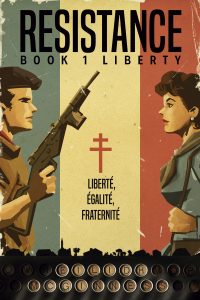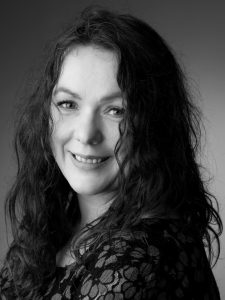Launch: Eilidh McGinness’s Resistance Book 1 – Liberty
INTERVIEW BY REBEKAH SIMMERS
Eilidh McGinness grew up in the Scottish Highlands and now lives in South-West France. She is publishing the first book of her Resistance trilogy today.
 How would you describe this book and its themes in a couple of sentences (what is your ‘elevator pitch’)?
How would you describe this book and its themes in a couple of sentences (what is your ‘elevator pitch’)?
An addictive look at the French Resistance during World War II through the experiences of a group of young recruits. A family saga set in South-West France during WW2, it focuses on the themes of bravery, courage, fear, treachery, and love in a time of war.
What life experiences have shaped you as a writer or affected how you approach your stories?
I have always loved reading and have always had a desire to write stories. I have been working on this book for a couple of years. I qualified as a lawyer and specialized latterly in criminal defence, so I try to explore themes of justice in my stories and show that the choice of what is right may not be black and white.
What attracted you to writing about this particular period of history and setting?
I live in the part of the Dordogne where this book is set. The area was a strong centre of resistance during WW2 so it was natural to write about that. All the main characters are fictional and live in or around the fictional village of Saint-Antoine-de-Double. They drift in and out of events that actually occurred and meet actual heroes of the resistance.
Is there a specific local item used within the story that holds special meaning to you? What and why?
There are many parts of the book which hold special meaning. One part that amuses me is the visit by the distiller to the hamlet of La Barde. I had the pleasure, by chance, of visiting a gentleman who still had such a still in use. My friends and I were able to sample his various brandies, such as pear, apricot, and plum.
At local farms, I am often offered home-made brandy (l’eau de vie). These are made with whatever fruit the producer favours, such as lemon, apricot, pear, cherry, or apple. They invariably have a high alcohol content. Sometimes they are delicious; sometimes barely drinkable. In the novel, the characters celebrate events with one or other of the many varieties of l’eau de vie available.
Goat’s cheese is a popular local dish here and Sabine the main character makes goat’s cheese on her parents’ farm. I was brought up on a farm. Agriculture and polyculture is popular here, so I have tried to thread through the story the values of rural life and sustainability.
When writing a story, what is your best strategy with getting to know your characters?
I try to imagine them carrying out the mundane part of their daily lives.
Tell us more about that. How is the present-day life around you the same as it was during the years in which your story takes place?
This area of France is agricultural with forestry and wine growing. Some of the winegrowers, who have status AB or Bio, use draft horses to plough. On other small-holdings here, I have seen people tossing hay by hand. Many locals are in the local chasse or hunting group, so wild boar, deer, and other game are regularly available. When you go to market, there are live hens, quails, and rabbits for sale, if you want to take them home to eat. I have seen people salting ham and hanging it to dry. One property I had for sale stank of tobacco, because the seller grew his own and dried it in the basement.
Who is your favorite minor character and why?
Carlos is the leader of a Spanish communist group. Hérisson, one of the novel’s main characters, meets Carlos when he and his friends are trying to find a resistance group to join. Carlos is a law unto himself.
What kind of research did you complete for the story? Are there any local museums or historical sites around you that were especially helpful or meaningful as your story came together?
I work as an estate agent in France. In the course of that work, I have marketed a number of houses that had a connection to the French Resistance – from former Nazi Headquarters to meeting places for Resistance leaders. Some of these buildings were burnt down as the Germans retreated and were rebuilt after the war. I have also met people who were actively involved in the Resistance.
Two local massacres form part of the novel: one of resistance recruits at Pont-Lasveyras, Payzac and the other of civilians at Mussidan. There is a memorial and museum at the site of the Pont-Lasveyras massacre and a memorial in Mussidan. The museum in Mussidan, Musée André Voulge, has a regular exhibition about the massacre at that site. There is also a museum and memorial to the Resistance at Saint-Etienne-de-Puycorbier.
I have listed the names of the people that died at these massacres at the end of a book together with a note that two of the victims of the Mussidan massacre have never been identified. Their identities are still being sought.
 Living there surrounded by the history and working in real estate has got to open a special door for you into the past. Can you tell us more about how that has influenced the story?
Living there surrounded by the history and working in real estate has got to open a special door for you into the past. Can you tell us more about how that has influenced the story?
I was surprised by the number of Resistance groups that were active in the area during WW2. One of the locations in the book is a bar and restaurant in Saint-Andre-de-Double 24410 Dordogne. Now there is a plaque outside in memory of the lady who ran the restaurant – Mme. Barrat – who allowed Resistance leaders to meet at her premises. Though now a private residence, I once marketed the building for sale and was able to explore the whole property. I used the location and Mme. Barrat in the book. It was quite exciting for me to be in the room of the house, which had once been the restaurant, and imagine both the actual people who met there and imagine my characters there too.
What is the last great book you read?
Margaret Atwood’s The Handmaid’s Tale.
![]()
HNS Sponsored Author Interviews are paid for by authors or their publishers. Interviews are commissioned by HNS.






